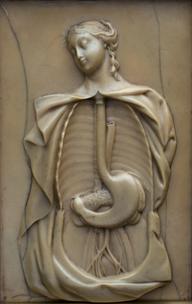

Obstetrical fillet, 1701-1900
- Made:
- 1701-1900 in unknown place




Fillet, ribbon, possibly 18th-19th century, silk and wood
Fillets were one of the first devices assisting childbirth that caused minimal danger to mother and child. The wooden stem was called an introducer. It was inserted into the birth canal then withdrawn. The longer silk strip was left looped around the foetus. The physician then put his hands through the two smaller loops and gently pulled to assist delivery. This silk example may have had limited usefulness. Soft fabrics were difficult to insert into the body. They also lacked the strength of materials such as leather or whalebone. Silk was unhygienic. It increased the danger of contracting puerperal fever. This is a fatal form of blood poisoning contracted during the birth from unsanitary instruments.
Details
- Category:
- Obstetrics, Gynaecology & Contraception
- Collection:
- Sir Henry Wellcome's Museum Collection
- Object Number:
- A615763
- Materials:
- covering, silk and wand, wood
- Measurements:
-
overall: 850 mm .017kg
- type:
- obstetrical fillet




